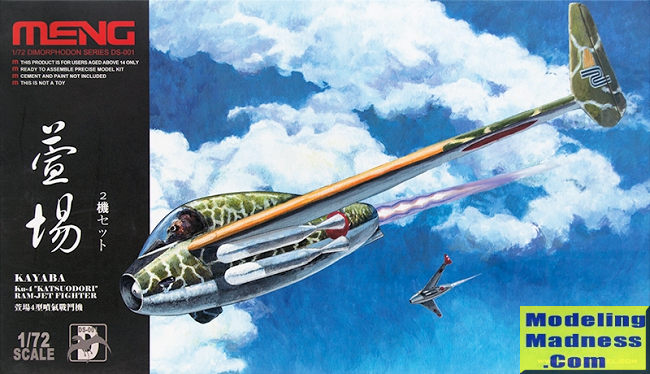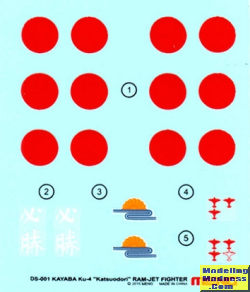
Meng 1/72 Kayaba Katsuodori
| KIT #: | DS-001 |
| PRICE: | $20.00 |
| DECALS: | Two options |
| REVIEWER: | Scott Van Aken |
| NOTES: |
|

| HISTORY |
The origin
of this Kayaba private design began in 1937 with the Kayaba Ramjet Study Group
who had been seeking to develop and produce a ramjet engine. In comparison to
the pulse-jet engine which injects fuel into the thrust chamber for ignition at
specific intervals, as demonstrated by the German V-1 missile, the ramjet
maintains a constant flow of fuel, thereby producing constant thrust. While the
Germans perfected both the pulse-jet and axial-flow turbojet, the result of the
Kayaba team research was the Kayaba Model 1 ramjet.
With
a total fuel reserve of 3,306 lbs. the
Katsoudori had an
estimated thirty minute combat flight duration. However,
fate intervened with the arrival of the German technology. The
Katsoudori project was
shelved when the Me
163-based rocket-powered designs were born, due to the fact that the 163 was
already a flight-proven design and the
Katsoudori was not. There was no time to further develop
the Kayaba ramjet and perform flight testing on an untried aircraft.
The Katsoudori would have had a projected 559 mph top speed with a climb to 32,808 feet in 3-minutes. This was much slower than the Me 163ís phenomenal climb of 16,000 fpm, but an acceptable range of 248 miles was expected during the thirty minutes of powered flight. A top ceiling of 49,212 feet would have enabled the Katsoudori to intercept any plane in 1945, including the formidable B-29 Superfortress plaguing the home islands.
| THE KIT |
 This is one of Meng's first kits and if not the first
overall, is probably their first aircraft kit. An interesting choice of subjects
considering that the whole 'Luft 46' fad had died down considerably by 2011 when
this was released.
This is one of Meng's first kits and if not the first
overall, is probably their first aircraft kit. An interesting choice of subjects
considering that the whole 'Luft 46' fad had died down considerably by 2011 when
this was released.
There are two kits in the box with two markings options, though you could easily adapt pretty much anything you want in terms of markings and camouflage. Right off the bat you have to make decisions. This involved drilling holes in the wings or fuselage. You see, you can display the model hanging from a mother aircraft which requires one set of holes. You can model it with the rocket assist units on the side of the fuselage, and you can install ground handling wheels.
All this needs to be done before the fuselage halves and wing halves are closed up. Most will probably go for the version that is mounted on the ground handling trolley, but it is nice to have the options as this would look neat hanging under a Ki-67, for example.
The cockpit is fairly
minimalist with a floor, rear bulkhead, seat, stick, and instrument panel. Both
the intake and exhaust sections have their respective compressor stages, though
I'm not sure if a ramjet would actually have these features. The one piece wings
have the fins and rudders mounted on the tips. Once the canopy is installed,
after the fuselage halves have been closed, that pretty well completes the
airframe. 
The rest of the construction sequences concern the attachment of the side rocket packs, the building of the ground handling dolly, the attachment of the wheeled undercarriage and the apparatus used to hang it from a bomb bay.
Instructions are well done and provide color information. There are two markings options on the small decal sheet, but as mentioned, it would not be a bad idea to simply use the insignia and rob unit markings from another source. I know I plan on doing that.
| CONCLUSIONS |
An easy looking build, especially if you leave off some of the accessories. The result will be a model that won't take up a lot of shelf space and you have two of them to build. Best of all, no issues with color police or accuracy experts so go nuts.
| REFERENCES |
http://discaircraft.greyfalcon.us/Kayaba%20Katsoudori.htm
If you would like your product reviewed fairly and fairly quickly, please contact the editor or see other details in the Note to Contributors.
Back to the Main Page Back to the Review Index Page Back to the Previews Index Page